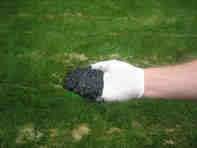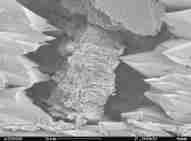What Causes Septic Tank Failure & How to Prevent It | WTE
How Sodium Binding destroys the Septic Tank Systems soakaway
| Most soils, even sandy soils, contain some 'fines' or small clay particles. Clay particles are not round, but are flat, jagged and arranged in 'plates'. Sodium causes a cationic bond to occur between these plates, literally sticking them together and forming a waterproof layer that the wastewater cannot drain through. |
Clay Particles under an electron microscope |
A 10 year documented research has recently been completed by Dr. Robert Patterson and it concludes: "The inevitable consequence of continual addition of sodium in septic tank effluent is a decrease in the soil's hydraulic conductivity leading, in many cases, to drainfield failure."
The causes of soakaway failure in septic tank systems
Septic system soil failure may be biological and/or chemical. These conditions often occur in sequence. When sodium causes chemical (cationic) exchanges, clay  particles bond together to form a waterproof layer which in turn causes the soakaway to fill with water, blocking the soil air spaces and causing biological death of air-dependent aerobic cleaning organisms in the soil. Anaerobic bacteria take over and increase the problem by forming a 'biomatt' of black slime which soon blocks all of the soakaway.
particles bond together to form a waterproof layer which in turn causes the soakaway to fill with water, blocking the soil air spaces and causing biological death of air-dependent aerobic cleaning organisms in the soil. Anaerobic bacteria take over and increase the problem by forming a 'biomatt' of black slime which soon blocks all of the soakaway.
Farmers have long recognized that over time, sodium in irrigation water causes the finer soil particles to bond together into impermeable layers. In agriculture, this chemical change causes structural changes in the soil, leading to land which drains poorly.
In the septic tank soakaway, problems begin when a thin impermeable layer of bonded fine silts and clay develops directly under the drains or on the soakaway trench floor or walls.
This layer grows and soon a "waterproof" barrier developes.
The problem is that if wastewater contains an unbalanced mix of total cations, with over 50% of the total cations (sodium, potassium, calcium and magnesium) being present as sodium, then it above problems will occur in most soils over time.
How to identify septic tank soakaway failures
If, when you have your septic tank emptied, wastewater is seen pouring back into the tank from the soakaway pipe, you have a problem.

